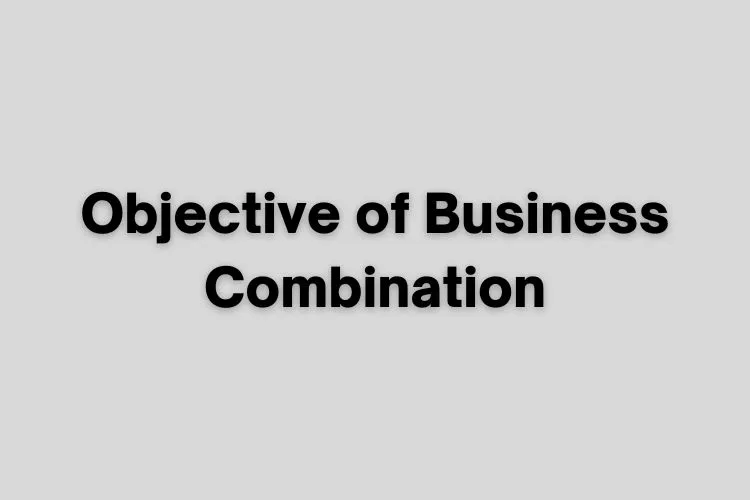Business Combinations Types Examples Horizontal, Vertical

Business combinations are the merger of two or more companies, usually to form a larger, more powerful company. Business combinations can be done in several different ways, including
- Mergers: Two companies join together to form a new company. This is the most common type of business combination.
- Acquisitions: One company buys another company.
- Joint Ventures: Two or more companies work together to create a new company.
- Spinoffs: One company splits into two or more new companies.
When it comes to business combinations, what does that even mean? How is it possible for two companies to come together and operate as one? In this article, we will discuss the basics of business combinations and how they work. We will also provide examples of how a business combination can help your company grow and reach new heights. So if you’re thinking about making a merger or acquisition, read on to learn more about what goes into making it a reality.
Elements and Terms of Business Combinations
When two or more businesses join forces, they form a business combination. This type of transaction can involve the acquisition of one company by another, the merger of two businesses, or the creation of a new business. There are a number of elements that must be considered before any such arrangement can be completed.
The parties involved in a business combination must weigh the benefits and drawbacks of the arrangement. The most important factors to consider include the financial and operational strength of each company, competition from rivals, and the impact on customers and employees.
In order to complete a successful business combination, all parties involved must have agreed to the terms. These agreements may cover matters such as ownership structures and management teams, pricing and product lines, research and development, marketing strategies, and distribution channels. Any difficult negotiations can be complicated by competing interests and hidden agendas.
Once all agreements have been reached, preparations can begin for implementation. This process may include negotiating contracts with staff members and customers, preparing financial statements for review by the boards of directors, and arranging for regulatory approvals. Completion of the deal is typically contingent on obtaining these necessary approvals in a timely manner.
There are several different types of business combinations, each with its own advantages and disadvantages. Here are the most common types of business combinations:
A merger is the most common type of business combination. In a merger, two companies join together to form a new company. This can be done in several different ways:
- Horizontal merger: Two companies that sell the same products merge together.
- Vertical merger: Two companies that sell related products merge together. For example, a company that makes cars might merge with a company that makes car parts.
- Conglomerate merger: Two companies from different industries merge together.
Mergers can be very successful if the two companies have complementary products or services. For example, if one company is good at making cars and the other is good at making car parts, they might be able to create a new, more powerful company by merging together. Mergers can also be very unsuccessful if the two companies have different goals or cultures.

Objectives of a Business Combination
A business combination is a merger or acquisition of two companies that results in one company owning substantially all the shares of the other. The objectives of a business combination are to (1) create value for shareholders by increasing shareholder value and (2) improve the efficiency, competitiveness and profitability of the combined company.
The benefits of a business combination include improved operating efficiency, increased market share, and cost savings. The most common reasons for pursuing a business combination are to gain access to new markets, strengthen competitive positions, and increase profits.
There are several factors to consider when deciding whether or not to pursue a business combination:
Acquisitions Business combinations
In an acquisition, one company buys another company. This can be done in several different ways:
- Hostile takeover: One company tries to buy another company against the wishes of the company’s management.
- Friendly takeover: One company buys another company with the approval of the company’s management.
- Backdoor takeover: A hostile takeover that succeeds by buying a large stake in the company and then taking over the company.
- White knight: A friendly takeover where a third party comes in to save a company from a hostile takeover.
Types of Business Combinations
Horizontal Business Combination
Vertical combinations
Lateral Combination
Advantages of Business Combinations
A business combination refers to the acquisition of one company by another. There are many benefits to acquiring a business, including economies of scale, increased customer base and market share, and new product offerings.
Combining businesses can also lead to cost efficiencies, as well as the development of new market segments. By working together, companies can accelerate innovation and improve customer service.
Additionally, combining businesses can create synergies that allow them to operate more effectively and efficiently. This can result in higher revenues and reduced costs for both companies. Finally, when two businesses are combined, their employees often crossover, allowing for increased sharing of best practices and knowledge across organizations.
Disadvantages Business Combinations
Combinations between different businesses can create a number of potential challenges, including potential antitrust issues. Another possible disadvantage is that the combination may not be cost-effective, as two businesses with different costs and operating styles may not share best practices. Additionally, a business combination could lead to reduced competition and increased prices for consumers.
Acquisitions can be very successful if the company that is buying the other company has complementary products or services. For example, if one company makes cars and the other company makes car parts, they might be able to create a new, more powerful company by buying the car part company. Acquisitions can also be very unsuccessful if the two companies have different goals or cultures.
Joint Ventures Business Combinations
A joint venture is a business combination where two or more companies work together to create a new company. This can be done in several different ways:
- Business partnership: Two or more companies form a partnership to share ownership of the new company.
- Joint venture company: Two or more companies create a new company to own and operate the new business.
- Consortium: A group of companies work together to bid on a project, then create a new company to actually do the project.
Joint ventures can be very successful if the two or more companies have complementary products or services. For example, if one company is good at making cars and the other company is good at making car parts, they might be able to create a new, more powerful company by working together. Joint ventures can also be very unsuccessful if the two companies have different goals or cultures.
Spinoffs Business Combination
A spinoff is a type of business combination where one company splits into two or more new companies. This can be done in several different ways:
Spinoffs can be very successful if the new companies have complementary products or services. For example, if one company is good at making cars and the other company is good at making car parts, they might be able to create a new, more powerful company by splitting the company into two new companies. Spinoffs can also be very unsuccessful if the new companies have different goals or cultures.
Consolidation Business Combinations
Consolidation is a type of business combination where two or more companies merge together to create a new company. This can be done in several different ways:
- Merger: Two or more companies merge together to create a new company.
- Acquisition: One company buys another company to create a new company.
- Joint venture: Two or more companies work together to create a new company.
Consolidations can be very successful if two or more companies have complementary products or services. For example, if one company is good at making cars and the other company is good at making car parts, they might be able to create a new, more powerful company by merging the two companies together. Consolidations can also be very unsuccessful if the two companies have different goals or cultures.
Divestitures Business Combination
Divestiture is a type of business combination where one company sells off a division of the company to another company. This can be done in several different ways:
